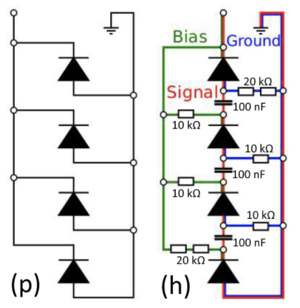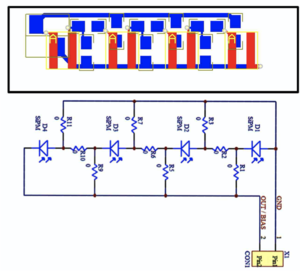Difference between revisions of "SiPM board"
| Line 2: | Line 2: | ||
The circuit configuration of the PCB varies depending on the number of SiPM's it needs to accommodate. For housing a single SiPM the configuration is to just connect it with ground and readout/ bias. However, for connecting multiple SiPM's there are two possible configurations: parallel (p) and hybrid (h) configuration as illustrated below. | The circuit configuration of the PCB varies depending on the number of SiPM's it needs to accommodate. For housing a single SiPM the configuration is to just connect it with ground and readout/ bias. However, for connecting multiple SiPM's there are two possible configurations: parallel (p) and hybrid (h) configuration as illustrated below. | ||
| − | [[File:Jepretan Layar 2020-06-23 pukul 4.23.54 PM.png|thumb|Parallel (p) and hybrid (h) configuration of SiPM board <ref>[S. Zimmermann. The panda barrel-tof detector. DPG-Frühjahrstagung, Münster. Austrian Academy of Sciences, Stefan Meyer Insitute for Subatomic Physics, 28th of March, 2017.]</ref>]] | + | [[File:Jepretan Layar 2020-06-23 pukul 4.23.54 PM.png|thumb|Parallel (p) and hybrid (h) configuration of SiPM board <ref>[S. Zimmermann. The panda barrel-tof detector. DPG-Frühjahrstagung, Münster. Austrian Academy of Sciences, Stefan Meyer Insitute for Subatomic Physics, 28th of March, 2017.]</ref>. The signal path is depicted in red, the bias current in green, and the ground in blue.]] |
| − | Both configurations are quite similar in term of performance, with the hybrid configuration having a slightly faster rising edge. However the hybrid configuration has more complexity, which might make the configuration more expensive to produce. Therefore for simplicity, the Muonpi project uses the parallel configuration is suitable for the Muonpi project as it keeps the simplicity while giving the option for adding SiPM further down the road. The schematic of the SiPM board for the Muon Pi project is shown below. | + | Both configurations are quite similar in term of performance, with the hybrid configuration having a slightly faster rising edge (few ns). Hence for applications that are very time sensitive, the hybrid configuration might be necessary. However the hybrid configuration has more complexity, which might make the configuration more expensive to produce. Therefore for simplicity, the Muonpi project uses the parallel configuration is suitable for the Muonpi project as it keeps the simplicity while giving the option for adding SiPM further down the road. The schematic of the SiPM board for the Muon Pi project is shown below. |
[[File:SiPMBoard.png| thumb| Schematic of the SiPM board used in the Muonpi project<ref>[L. Nies, “Development of a sipm-based readout-module for the characterization of various scintillation materials (bachelor’s thesis),” (August 2017).]</ref>]] | [[File:SiPMBoard.png| thumb| Schematic of the SiPM board used in the Muonpi project<ref>[L. Nies, “Development of a sipm-based readout-module for the characterization of various scintillation materials (bachelor’s thesis),” (August 2017).]</ref>]] | ||
Revision as of 16:33, 23 June 2020
The SiPM board is a printed circuit board (PCB) designed to dock and process the signal from the SiPM-scintillator coupling into a readout. Ideally no information such as timing from the scintillator should be lost, and the signal could be amplified/ processed with the board. In some applications involving significant temperature fluctuations, a compensator could also be built into the board. For the Muonpi project, the board should just be able to dock the SiPM-scintillator coupling to the readout.
The circuit configuration of the PCB varies depending on the number of SiPM's it needs to accommodate. For housing a single SiPM the configuration is to just connect it with ground and readout/ bias. However, for connecting multiple SiPM's there are two possible configurations: parallel (p) and hybrid (h) configuration as illustrated below.

Both configurations are quite similar in term of performance, with the hybrid configuration having a slightly faster rising edge (few ns). Hence for applications that are very time sensitive, the hybrid configuration might be necessary. However the hybrid configuration has more complexity, which might make the configuration more expensive to produce. Therefore for simplicity, the Muonpi project uses the parallel configuration is suitable for the Muonpi project as it keeps the simplicity while giving the option for adding SiPM further down the road. The schematic of the SiPM board for the Muon Pi project is shown below.

- ↑ [S. Zimmermann. The panda barrel-tof detector. DPG-Frühjahrstagung, Münster. Austrian Academy of Sciences, Stefan Meyer Insitute for Subatomic Physics, 28th of March, 2017.]
- ↑ [L. Nies, “Development of a sipm-based readout-module for the characterization of various scintillation materials (bachelor’s thesis),” (August 2017).]